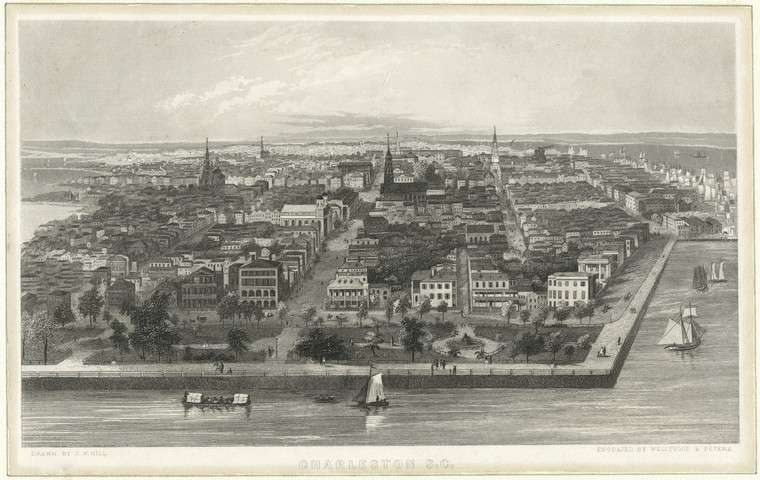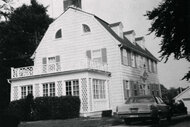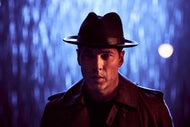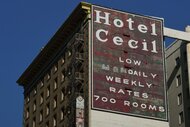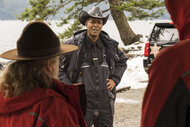Create a free profile to get unlimited access to exclusive videos, sweepstakes, and more!
Lavinia Fisher, America's 'first female serial killer' that wasn't

If you ever find yourself on a ghost tour in Charleston, South Carolina, you'll probably end up hearing the terrifying tale of Lavinia Fisher.
In 1819, or so the story goes, Lavinia Fisher and her husband John ran an inn six miles north of Charleston. Fisher was widely known as a charming and beautiful woman who nonetheless kept strangely rough company. She would often flirt with and entertain male guests before offering them a cup of tea right before bed. It was her own blend, brewed with a secret ingredient: deadly oleander. The tea would send the men off to sleep... right before her husband stabbed them to death and the couple dumped their bodies in the cellar. No one could figure out what was happening to the missing men at the Six Mile House, until John Peoples, a guest who, luckily, did not care for tea, escaped their clutches.
Once arrested, Fisher and her husband were sentenced to hang. When Fisher pleaded with the judge that he couldn't hang a married woman, he told her they'd simply hang John first. When the day came, she insisted on wearing her wedding dress. This vision in white refused to go to the scaffold willingly. She screamed and pleaded for mercy from anyone who would listen. But once she realized any hope of salvation would not be forthcoming, her beautiful face darkened. Before the noose was tightened, she had one last thing to tell the crowd: "If anyone has a message for Hell, give it to me, and I'll carry it!" And to this day, her vengeful ghost haunts the Old City Jail.
It's a haunting story. And almost none of it is true.
Oh, Lavinia Fisher did hang, but for highway robbery, not murder, and she certainly didn't hang in her wedding dress. She didn't even have one to wear, what with her home being burned down and all. So how on Earth did a highwaywoman steal the title of "America's first female serial killer"?
Because there's almost no documentation of Lavinia Fisher's life before she enters the historical narrative in 1819, the best way to understand who she was is to understand where she was: the outskirts of Charleston.
Early 19th century Charleston was a bustling metropolis, second only in population to New York City in the nascent United States. While the state government moved from Charleston to Columbia in 1788, it nonetheless outranked its sister city in the eyes of many. As a port, it served as an important center of commerce for both wagons and ships. It was also a major market for the selling of enslaved people. From 1790 to 1820, where we enter this story, enslaved people and free people of color made up more than half of the population of the city. Charleston was the only city in the United States of America during that time where the slaveholders were outnumbered by the people they enslaved.
On top of this, Charleston's wealth was hoarded by the elite. According to Maurie D. McInnis in The Politics of Taste in Antebellum Charleston, "Throughout the antebellum period, the top four percent of the population controlled more than 50 percent of the city's wealth." Additionally, after the War of 1812, the United States of America would experience an economic downtown that would culminate with the Panic of 1819 — what some economists call America's first Great Depression.
Against this backdrop of stark racial, class, and economic tensions, Charleston was a plum target for thieves. Traders visiting Charleston to ply their wares were often beset by highwaymen on the road into Charleston (to steal their goods) and the road out of Charleston (to steal their earnings). These robberies become such a problem that Charleston residents became fearful that it would discourage trade and further damage their city's economy.
If you happened to be traveling to Charleston by wagon in 1819, you'd need to stop regularly to rest and water your horses to complete your journey. To do so, you'd pull over at an inn, usually named after how many miles it lay outside town.
Like Six Mile House, six miles north of Charleston.
On February 19, 1819, a mob of white men set out from Charleston to take the law into their own hands. A rash of recent robberies on the road hadn't turned up any suspects, as the victims could not identify their assailants. This mob thought they could solve the mystery. When the mob arrived at Six Mile House, they ordered everyone inside to vacate the premises so they could search the place. Once satisfied, the mob left one member, David Ross, to keep watch, and moved on to their next target.
When the Six Mile House group returned to find Ross still in the inn, they were not happy. As Ross later reported to the authorities, a man named William Hayward assaulted him and demanded that he leave. When Ross asked if he could just get his things, Hayward threatened to shoot him. John and Lavinia Fisher arrived shortly afterwards and began to beat him. As Ross struggled to escape, Lavinia put his head through a windowpane. He managed to get out of the house, but the Six Mile House group pursued, firing at him. "You damned infernal rascal," John screamed at Ross, "if I ever catch you, I will give you a hundred lashes."
Shortly after that, John Peoples arrived at the Six Mile House to water his horses. According to his affidavit, he was set upon by a group of "nine or ten persons" armed to the teeth. While Peoples could not identify his assailants, he did note that there was a woman in the group. Unsurprisingly, they began to beat him mercilessly too. While Peoples was able to get away with his wagon, two of his assailants pursued on horseback and robbed him at gunpoint. While he wasn't able to identify the men who robbed him, he was able to later identify William Hayward, John Fisher, and Lavinia Fisher in a line-up.
With some actual leads in hand for once, the sheriff took a group of men to the Six Mile House to arrest them the next day. The group surrendered immediately. While searching the property, the sheriff's men found the skin of a cow that had been reported as stolen. Their search complete, they set fire to the Six Mile House, destroying everything inside.
The Six Mile House group was sent to the Old City Jail in Charleston to await trial. Ultimately, William Hayward and the Fishers were charged with common assault and assault with the intent to murder. As husband and wife, John and Lavinia were given a single jail cell to share while they waited, which may have not been the best idea. The couple tried to escape with an accomplice on September 13, but Lavinia was left behind after the good old-fashioned blanket rope broke and John refused to leave her.
On January 17, 1820, John and Lavinia were finally convicted of their charges of common assault and assault with the intent to murder against David Ross. They were additionally charged and convicted of highway robbery against John Peoples. Highway robbery was a capital crime, which meant that the Fishers had just been sentenced to death.
John spent the time before their execution consulting with a Protestant pastor, but Lavinia found no such comfort in religion. She insisted on her innocence and truly believed that there would be some intervention before the end. She watched the guards like a hawk for news and jumped at the hint of paper, assuming it was her pardon.
But no such salvation arrived. On February 18, 1820, the Fishers were delivered from the Old City Jail to the gallows. John was resigned to his fate, but Lavinia refused to leave the carriage. When the guards bodily dragged her out, she began begging and pleading with the crowd to help her, alternating between protesting her own innocence, curses, and blasphemy. The pastor stationed at the gallows tried to sooth her into making peace with God before the end. "Cease!" she snarled at him. "I will have none of it. Save your words for others that want them. But if you have a message you want to send to Hell, give it to me; I'll carry it."
And after that — the drop.
The true story of Lavinia Fisher has no tea, no basement, and no murders. Oddly enough, two corpses were found in the woods near Six Mile House a few days after the Fishers were arrested, but these were never attributed to the Fishers. In fact, they appear to have never been persecuted as murders at all. So how do we get from the highwaywoman of history to the Lavinia of legend?
Well, the Fishers' execution drew a lot of public interest. Lavinia was not, by a long shot, the first woman executed by hanging in what would become the United States of America. That would be Jane Champion, two centuries prior. Nonetheless, it was still novel to see a woman be executed for a capital crime, especially alongside her husband. The few details available about Lavinia herself, combined with her shocking final words to the crowd, proved to be an irresistible combination of unknown and lurid.
According to Bruce Orr, whose book Six Miles to Charleston is the authoritative text on John and Lavinia Fisher, the legend was born in 1830, with the publication of Peter Neilson's Six Years' Residence in America. Neilson, a Scottish businessman, claimed that he had personally witnessed the Fishers' execution. (He hadn't; he resided in the States from 1822 to 1828.) To thrill his audience, he embroidered the story to make it darker and more horrifying, filling it with murder and skeletons.
After that, it was open season, and the legend of Lavinia Fisher began to take killer shape. As Charlestonian historian Beatrice St. Julien Ravenel noted in 1947's Charleston Murders, people feel free to imagine Lavinia however they see fit. Murder? Sure! Poison tea? Why not? Sorcery? Well, she mentioned the Devil, it's practically true! The real Lavinia slowly faded into the background, unable to hold a candle to "Lovely Lavinia," as she's dubbed in St. Julien Ravenel's retelling.
So, ultimately, those Charleston ghost tour guides are right. Lovely Lavinia is a ghost — because she was never truly real to begin with.
